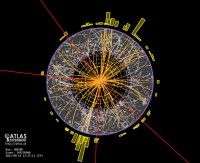LHC begins 2012 with a world record in collision energy

The collision of two 4 TeV proton beams at the LHC’s four interaction points signalled the start of this year's physics data-taking by the LHC experiments. The collision energy of 8 TeV set a new world record, and considerably increases the discovery potential of the LHC.
Although the increase in collision energy is relatively modest, it translates to an increased discovery potential that can be several times higher for certain hypothetical particles. Some such particles, for example those predicted by supersymmetry, would be produced much more copiously at the higher energy. Supersymmetry is a theory in particle physics that goes beyond the current Standard Model, and could account for the dark matter of the Universe.
"Its very exciting. When one is so close to the LHC machine, it is great to see the ramp up going so well." Prof. Peter Clarke, Institute for Particle and Nuclear Physics
Standard Model Higgs particles, if they exist, will also be produced more copiously at 8 TeV than at 7 TeV, but background processes that mimic the Higgs signal will also increase. That means that the full year’s running will still be necessary to convert the tantalising hints seen in 2011 into a discovery, or to rule out the Standard Model Higgs particle altogether.
"The LHC and its experiments are well positioned to have a third year of data-taking at higher energy and at increased collision rates. Members of the Edinburgh ATLAS and LHCb groups were in the pit when the beams were switched on and we will be in the midst of the exciting physics results to come from the 2012 data." Prof. Franz Muheim, Head of the Institute for Particle and Nuclear Physics
“The increase in energy is all about maximising the discovery potential of the LHC,” said CERN Research Director Sergio Bertolucci. “And in that respect, 2012 looks set to be a vintage year for particle physics.”
"We are very excited. During this year we hope to collect enough data for a first real answer on the Higgs Boson's existence. It may still take several years to discover or exclude it, particularly at low mass, and beyond doubt." Phil Clark, Institute for Particle and Nuclear Physics
The LHC is now scheduled to run until the end of 2012, when it will go into its first long shutdown in preparation for running at an energy of 6.5 TeV per beam as of late 2014, with the ultimate goal of ramping up to the full design energy of 7 TeV.
Watch a video about the LHC restart.

